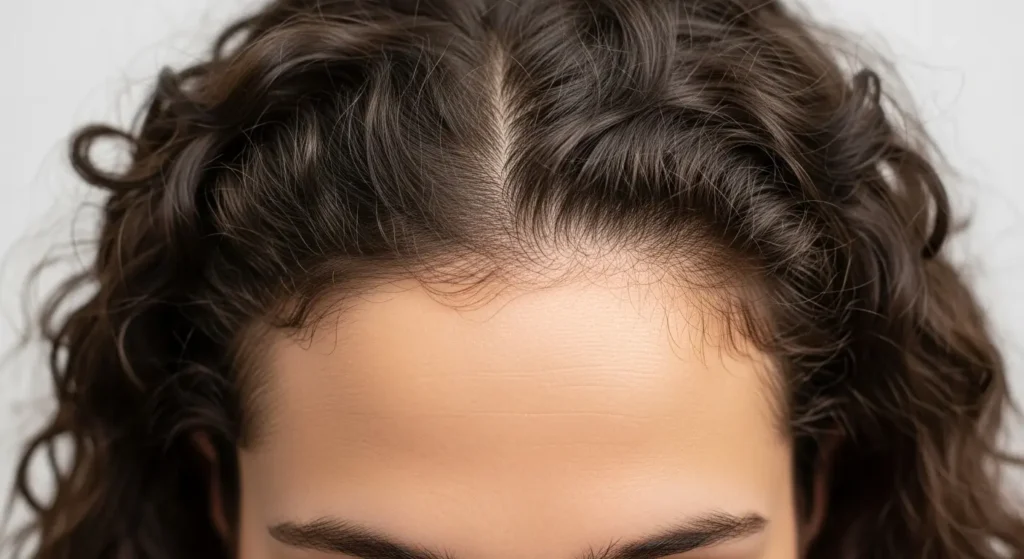Are you noticing unusual shedding, thinning, or breakage in your curls? Curly hair and hair loss can feel especially alarming since curls often make every strand lost seem more visible.
In this guide, you’ll learn how to tell normal shedding from true hair loss, uncover the common causes (from hormones to hairstyles), and explore expert-backed solutions to protect your curls.
With trusted medical insights and practical care tips, this article helps you restore confidence and keep your curls healthy.
Common Causes of Hair Loss in Curly Hair

Natural Shedding vs. Breakage
One of the most confusing parts of curly hair care is knowing whether you’re truly losing hair or just experiencing breakage.
- Shedding: A natural process where old hairs fall out with the bulb (root) still attached. Most people shed 50–100 hairs a day, but curls often trap these strands until wash day, making the loss look dramatic.
- Breakage: Hair snaps mid-shaft, leaving frayed or uneven ends. This happens due to dryness, over-brushing, or chemical damage.
Pro tip: Inspect fallen hairs. If you see a small white bulb, it’s shedding. If not, it’s likely breakage.
Visibility of Shedding in Curl Patterns
Unlike straight hair, shed hairs in curls tend to coil and stay trapped until you detangle or wash. That’s why curly-haired people often see clumps of hair in the shower, even though the amount may still be within the normal range.
Biological & Hormonal Factors
Hormonal Shifts (Stress, Pregnancy, Postpartum)
Hormones strongly influence both curl pattern and density. Many women notice curl loosening or excessive shedding after:
- Pregnancy & Postpartum: Estrogen drop causes telogen effluvium—temporary, diffuse shedding.
- Stress: Cortisol spikes can disrupt the growth cycle, leading to thinning.
- Menopause: Hormonal decline may weaken follicles and change curl texture.
Telogen Effluvium & Other Clinical Conditions
- Telogen Effluvium (TE): Triggered by illness, surgery, or major stress, pushing many hairs into the shedding phase at once.
- Anagen Effluvium: Sudden loss during the growth phase, often due to chemotherapy.
- Androgenetic Alopecia (pattern hair loss): Though less studied in curls, it can affect scalp density over time.
Mechanical & Styling-Related Hair Loss
Traction Alopecia from Tight Hairstyles
Curly and coily hair types are often styled in braids, twists, ponytails, or extensions. When too tight, these create traction alopecia, gradual thinning at the temples, hairline, and crown. Early signs include:
- Redness or bumps near the hairline
- Receding edges
- Tenderness of the scalp
Scalp Conditions Like CCCA
Central Centrifugal Cicatricial Alopecia (CCCA) primarily affects women of African descent with tightly coiled hair. It causes scarring and permanent follicle loss if untreated. Early detection is crucial; seek a dermatologist if you notice a widening part or scaly patches.
Product-Related & Hygiene-Related Contributing Factors
Product Buildup & Clogged Follicles
Curly hair thrives on moisture, but heavy conditioners, gels, and oils can cause buildup. This may clog follicles, irritate the scalp, and contribute to shedding.
Solution: Clarify once every 2–4 weeks with a sulfate-free cleanser.
Over-Processing, Heat, and Improper Detangling
- Frequent straightening or chemical relaxers weaken hair bonds.
- Rough detangling with small-toothed combs can break strands.
- Excessive blow-drying without heat protection accelerates dryness.
Pro tip: Always detangle curls when damp with a wide-tooth comb or fingers, working from ends upward.
Best Practices for Caring for Curly Hair and Minimizing Hair Loss
Curly Girl Method & Gentle Handling
The Curly Girl Method emphasizes:
- Co-washing (cleansing with conditioner) instead of harsh shampoos
- Avoiding sulfates, silicones, and parabens
- Using diffusers instead of direct heat
This routine reduces stress on curls and helps retain moisture—two factors essential for preventing breakage.
Moisture, Sleep Care & Protective Measures
- Silk/satin pillowcases prevent friction and reduce morning shedding.
- Protective styles (loose braids, buns) help curls stay intact without strain.
- Regular deep conditioning improves elasticity and prevents breakage.
Nutritional Support & Lifestyle Adjustments
Healthy curls start within. Consider:
- Vitamins & minerals: Biotin, Vitamin D, Iron, and Zinc support hair growth.
- Balanced diet: Eggs, spinach, nuts, and salmon promote follicle strength.
- Scalp massage: Stimulates circulation and improves nutrient delivery.

Frequently Asked Questions (FAQs)
Is it normal to lose hair on wash day?
Yes. Curly hair traps shed hairs, so you may release several days’ worth during detangling. As long as you don’t notice bald spots or thinning patches, it’s likely normal.
When should I worry—what signs indicate real hair loss?
A widening part or a thinning crown
Noticeable bald spots or receding hairline
Excessive shedding beyond six months
If these apply, consult a dermatologist or trichologist.
Can hormones really change my curl pattern or cause thinning?
Yes. Hormonal fluctuations from pregnancy, menopause, or thyroid issues can alter curl structure and trigger shedding.
Are certain curly hair routines making it worse?
Yes—tight protective styles, harsh detangling, and heat overuse can accelerate loss. Switch to gentler methods.
What’s the difference between hair loss and damage?
Hair loss: Shedding from the follicle.
Damage: External breakage due to styling or environment.
Next Steps
If thinning curls or unexplained shedding are causing concern, don’t wait until the problem worsens. Book a personalized consultation with Dr. Rana Irfan in Islamabad, an internationally recognized hair restoration expert. With advanced diagnostic tools and proven treatments, you’ll receive a tailored plan to protect your curls and restore density.
